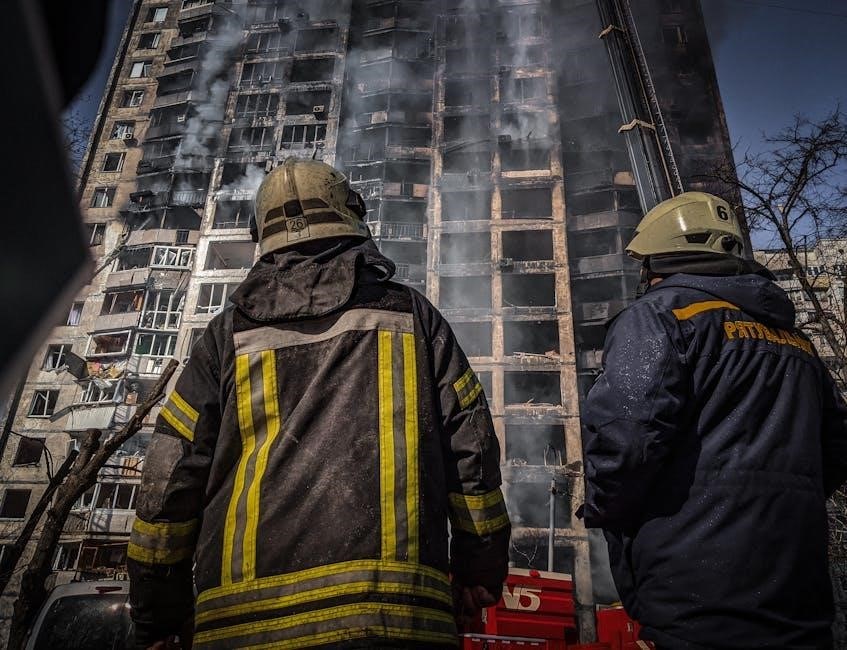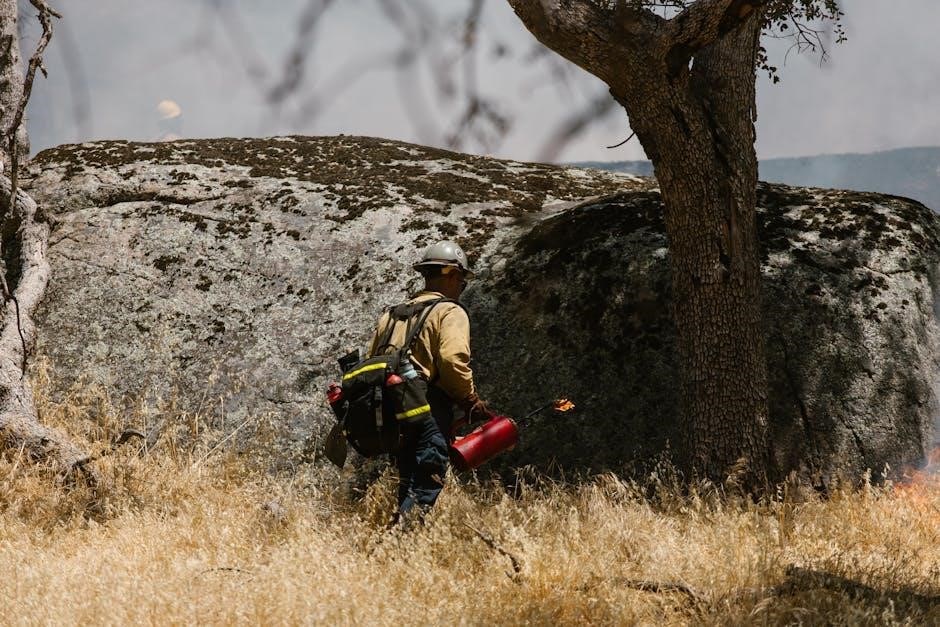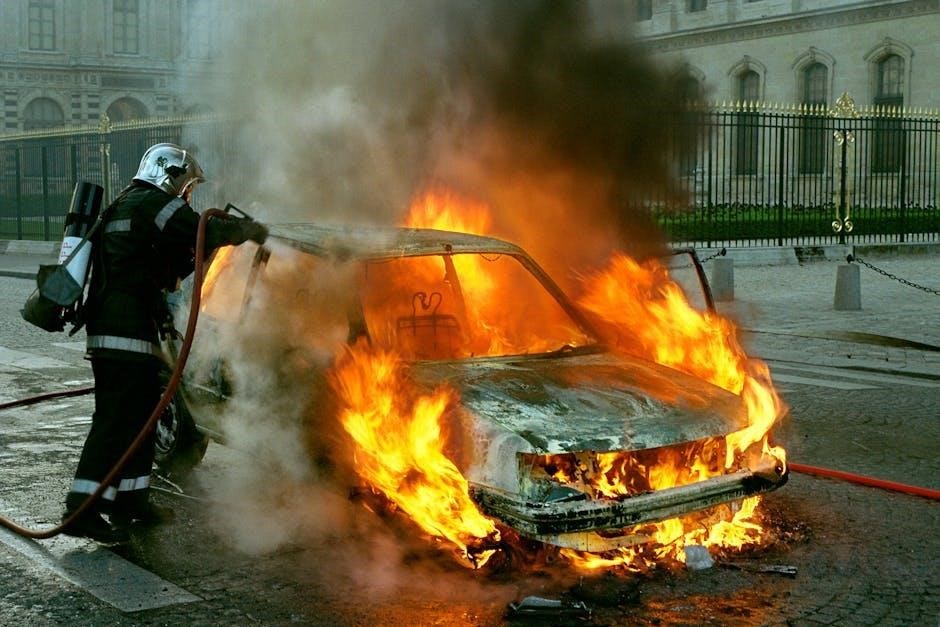Fire extinguishers are essential portable devices for controlling small fires before they escalate. They play a vital role in fire safety by preventing fires from spreading. With various types designed for specific fire classes, understanding their proper use is critical for effective fire management and safety.
1.1 Importance of Fire Extinguishers in Fire Safety
Fire extinguishers are crucial in fire safety as they provide immediate control over small fires, preventing them from escalating. They protect lives, property, and assets by allowing individuals to act swiftly during emergencies. Proper use of extinguishers can minimize damage and buy time for evacuation. As a first line of defense, they are essential in any fire safety strategy, ensuring quick response and containment before professional help arrives.
1.2 Brief Overview of Fire Extinguisher Types
Fire extinguishers are categorized into several types based on the extinguishing agents they use. These include water, foam, dry chemical, carbon dioxide, wet chemical, and Halon. Each type is designed to combat specific classes of fires, such as Class A for solids, Class B for liquids, and Class C for electrical fires. Understanding these types is essential for effective fire management and ensuring the right tool is used in emergency situations to maximize safety and efficiency. Proper selection is critical to avoid exacerbating a fire.

Classification of Fires
Fires are classified into types based on the combustible materials involved. Common classes include A (solids), B (liquids), C (electrical), D (metals), and K (cooking oils). Understanding these classifications is crucial for selecting the appropriate fire extinguisher type and ensuring effective fire management.
2.1 Class A Fires: Solid Combustible Materials
Class A fires involve solid combustible materials, such as wood, paper, cloth, plastics, and trash. These fires are common in households and commercial spaces. They are fueled by carbon-based materials and can spread rapidly if not controlled. Water-based extinguishers are typically used to combat Class A fires, as they cool the fuel and remove heat. Proper extinguisher selection is crucial to ensure effective fire suppression and prevent further damage. Understanding Class A fires is fundamental to fire safety and response strategies.
2.2 Class B Fires: Flammable Liquids and Gases
Class B fires involve flammable liquids or gases, such as petrol, oil, grease, paint, or propane. These fires can spread quickly and are highly dangerous due to their volatile nature. Foam or dry chemical extinguishers are typically used to combat Class B fires, as they smother the flames and break the fuel-oxygen connection. Water should never be used, as it can cause the fire to spread. Proper extinguisher selection is critical to safely manage these hazardous situations and prevent escalation. Understanding Class B fires is essential for effective fire safety strategies.
2.3 Class C Fires: Electrical Equipment
Class C fires involve electrical equipment, such as short circuits, faulty wiring, or overloaded systems. These fires are unique because they can reignite if the power source is not disconnected. Carbon dioxide (CO2) or dry chemical extinguishers are typically used, as they do not conduct electricity and can effectively smother the flames. Water should never be used due to the risk of electrical shock. Properly addressing Class C fires requires ensuring the power is off before extinguishing to prevent further hazards and ensuring safety. Understanding their dynamics is crucial for effective fire management.
2.4 Class D Fires: Combustible Metals
Class D fires involve combustible metals like magnesium, titanium, or sodium. These fires are highly hazardous due to the intense heat and reactivity of metal fuels. Water should never be used, as it can cause violent reactions or spread the fire. Specialized dry powder extinguishers are required to smother the flames and starve the fire of oxygen. Proper training is essential for handling Class D fires, as incorrect methods can exacerbate the situation and lead to severe consequences, including explosions or rapid fire spread.
2.5 Class K Fires: Cooking Oils and Fats
Class K fires involve cooking oils and fats, commonly occurring in commercial kitchens. These fires are highly hazardous due to the high heat and splattering of ignited oils. Water is ineffective and dangerous, as it can cause the fire to spread. Wet chemical extinguishers are specifically designed for Class K fires, as they cool the oil and form a barrier to prevent reignition. Proper training is crucial, as incorrect methods can worsen the situation. Always aim to cover the entire surface and monitor for potential flare-ups after extinguishing.
Types of Fire Extinguishers
Fire extinguishers are categorized into types like water, foam, dry chemical, CO2, wet chemical, and Halon, each designed for specific fire classes to ensure safe and effective use.
3.1 Water-Based Extinguishers
Water-based extinguishers are effective for Class A fires, involving solid combustible materials like wood, paper, and cloth. They work by cooling the fuel, reducing temperatures below the ignition point. However, they are unsuitable for Class B, C, or K fires, as water can worsen situations involving flammable liquids, electrical equipment, or cooking oils. These extinguishers are commonly used in offices, homes, and areas with ordinary combustible materials, but caution is needed to avoid using them in inappropriate fire scenarios.
3.2 Foam-Based Extinguishers
Foam-based extinguishers are ideal for Class A and B fires, involving solids and flammable liquids. They create a thick foam barrier, starving the fire of oxygen and cooling the fuel. Effective in industrial settings and areas with flammable liquids, foam extinguishers are versatile and safe for various environments; They are not suitable for Class C or electrical fires, as foam can conduct electricity. Regular maintenance is essential to ensure their effectiveness in emergency situations;
3.3 Dry Chemical Powder Extinguishers
Dry chemical powder extinguishers are versatile and widely used for Class B (flammable liquids) and Class C (electrical) fires. They work by smothering the fire and interrupting the chemical reaction. Effective in industrial and commercial settings, they are a popular choice due to their broad application. However, they are not suitable for Class A fires as they do not cool the fuel, potentially allowing re-ignition. Regular maintenance is essential to ensure their reliability in emergencies.
3.4 Carbon Dioxide (CO2) Extinguishers
Carbon dioxide extinguishers are highly effective for Class C fires involving electrical equipment and Class B fires with flammable liquids. CO2 works by displacing oxygen, suffocating the fire without causing damage to sensitive equipment. They are ideal for use in laboratories, data centers, and industrial settings. However, CO2 extinguishers are not suitable for Class A fires or those involving combustible metals, as they do not provide a cooling effect, which is necessary for such fires. Proper training is essential for their safe and effective use in emergencies.
3.5 Wet Chemical Extinguishers
Wet chemical extinguishers are specifically designed to combat Class K fires involving cooking oils and fats. They work by creating a cooling foam blanket that smothers the fire and prevents re-ignition. Ideal for use in commercial kitchens, these extinguishers are effective on deep fat fryers and grease-heavy equipment. They are not suitable for Class A or B fires, making them specialized tools for high-risk cooking environments. Their unique formulation ensures safe and efficient fire control in scenarios where other extinguishers may fail.
3.6 Halon Extinguishers
Halon extinguishers are highly effective for Class B and Class C fires, particularly in electrical equipment. They work by displacing oxygen and breaking the chemical reaction. However, Halon is an ozone-depleting substance, and its production is phased out due to environmental concerns. Despite this, existing Halon extinguishers are still used in critical areas like data centers and laboratories. They leave no residue, making them ideal for sensitive equipment, but alternatives are now being sought to address environmental impact while maintaining fire safety standards.

Fire Extinguisher Uses and Suitability
Fire extinguishers must be selected based on the specific fire class to ensure effectiveness and safety. This section outlines the appropriate applications for each extinguisher type.
4.1 Using Water Extinguishers on Class A Fires
Water extinguishers are ideal for Class A fires, which involve solid combustible materials like wood, paper, and cloth. They work by cooling the fuel, reducing temperatures below the ignition point. This extinguishing method is highly effective for these fires, as water penetrates deep into the material, ensuring complete extinguishment. However, water should never be used on electrical or flammable liquid fires, as it can worsen the situation. Proper training ensures safe and effective use of water extinguishers in Class A scenarios.
4.2 Using Foam Extinguishers on Class B Fires
Foam extinguishers are highly effective for Class B fires, which involve flammable liquids like gasoline, oil, and paint. The foam creates a barrier on the surface, smothering the fire and preventing reignition. It cools the fuel, reducing the risk of spreading. Foam is particularly useful in industrial settings where such fires are common. Proper training is essential to ensure safe and effective use, as improper application can lead to fire escalation. Always prioritize safety when handling flammable liquid fires with foam extinguishers.
4.3 Using Dry Chemical Extinguishers on Class B and C Fires
Dry chemical extinguishers are versatile and widely used for Class B (flammable liquids) and Class C (electrical) fires. They work by interrupting the chemical reaction of the fire, effectively starving it of oxygen. These extinguishers are particularly effective in commercial and industrial settings where such hazards are common. However, they should not be used in confined spaces or on Class D fires. Always follow the PASS method and ensure proper training before using them to maximize safety and effectiveness.
4.4 Using CO2 Extinguishers on Electrical Fires
CO2 fire extinguishers are highly effective for Class C fires, which involve electrical equipment. They work by displacing oxygen, preventing reignition. Non-conductive and non-corrosive, they are ideal for electrical fires without damaging equipment. However, they are ineffective on Class A or B fires. Use them in well-ventilated areas to avoid inhalation risks, making them crucial for environments with electrical hazards.
4.5 Using Wet Chemical Extinguishers on Class K Fires
Wet chemical extinguishers are specifically designed for Class K fires, which involve cooking oils and fats. These extinguishers release a soapy foam that smother the fire, cooling the oil and preventing reignition. They are highly effective in commercial kitchens and food service areas. Unlike other extinguishers, wet chemicals are safe for use on high-temperature cooking equipment, making them indispensable in environments where grease and oil fires are common. Always ensure proper training before using them.

How to Use a Fire Extinguisher Properly
Using a fire extinguisher properly involves the PASS method: Pull the pin, Aim at the base, Squeeze the handle, and Sweep the nozzle. Stand 8 feet away for safety and effectiveness. Proper training and awareness of fire types ensure correct usage and minimize risks.
5.1 The PASS Method: Pull, Aim, Squeeze, Sweep
The PASS method is a simple, memorable technique for using fire extinguishers effectively. Start by PULLING the safety pin to release the lock. Next, AIM the nozzle at the base of the fire to target the fuel source. Then, SQUEEZE the handle to release the extinguishing agent. Finally, SWEEP the nozzle back and forth, covering the entire area of the fire. This method ensures proper technique and helps extinguish fires safely and efficiently. Always stand at a safe distance, typically 8 feet away, for optimal effectiveness.
5.2 Safety Precautions Before Using an Extinguisher
Before using a fire extinguisher, ensure you are properly trained and understand its operation. Always assess the fire’s size and intensity to determine if it’s safe to attempt extinguishing. Choose the correct extinguisher type for the fire class. Ensure the extinguisher is easily accessible and fully charged. Avoid using the wrong extinguisher, as it may worsen the fire. Never fight a fire that is too large or spreading rapidly; prioritize evacuating the area and calling professionals.
5.3 Standing Distance for Effective Fire Extinguishing
Always maintain a safe distance from the fire when using an extinguisher, typically around 8 feet, to ensure visibility and effectiveness. This distance helps prevent overheating and allows precise aiming. Stand too close, and the extinguishing agent may not cover the fire adequately. Too far, and the agent may dissipate before reaching the fire. Adjust your position based on the extinguisher’s range and the fire’s size, ensuring you can safely approach without being overwhelmed by heat or smoke.

Fire Extinguisher Maintenance and Inspection
Regular inspection ensures extinguishers are accessible, fully charged, and free from damage. Proper storage and routine servicing are critical to maintain reliability in emergency situations.
6.1 Regular Inspection Requirements
Regular inspections are crucial to ensure fire extinguishers are fully functional and accessible. Inspectors must check for damage, wear, and proper storage orientation. All extinguishers should be easily reachable and free from obstructions. Monthly visual checks by users and annual professional inspections are mandatory. Pressure gauges must indicate proper charging, and tags should be updated with inspection dates. Compliance with local fire codes ensures reliability in emergencies, maintaining safety standards effectively.
6.2 Recharging and Refilling Procedures
Recharging and refilling fire extinguishers must be performed by trained professionals to ensure safety and effectiveness. After use, extinguishers are inspected for damage and depressurized. The cylinder is then emptied, cleaned, and recharged with the appropriate agent. For CO2 and wet chemical extinguishers, refilling involves replenishing the agent to the recommended level. Proper testing and re-pressurization are conducted before returning the extinguisher to service. Detailed records of these procedures are maintained to ensure compliance with safety standards and regulations.
6.3 Storage and Accessibility Guidelines
Fire extinguishers must be stored in easily accessible locations, protected from heat sources, moisture, and corrosive substances. They should be mounted on walls or placed on stable stands, positioned upright, and secured to prevent movement. Extinguishers should be visible, with clear pathways for quick access during emergencies. Storage areas must comply with local fire codes and maintain a temperature range suitable for the extinguisher type. Regular inspections ensure they remain functional and ready for immediate use when needed.

Fire Extinguisher Placement and Accessibility
Fire extinguishers should be placed in visible, accessible locations, ensuring easy reach during emergencies. They must be positioned near exits and high-risk areas, avoiding obstructions.
7.1 Strategic Placement in Commercial Buildings
In commercial buildings, fire extinguishers should be strategically placed near exits, stairways, and high-risk areas like kitchens or electrical rooms. They must be visible, accessible, and within 75 feet of any point. Proper placement ensures quick access during emergencies, minimizing fire spread. Regular inspections are crucial to maintain functionality and compliance with safety standards.
7.2 Placement in Residential Areas
In residential areas, fire extinguishers should be placed on every level of the home and in high-risk zones like kitchens and garages. They should be visible, easily accessible, and within reach of adults. Ideally, one extinguisher should be located near each sleeping area for quick access during emergencies. Regular inspections and maintenance ensure they remain functional, providing a first line of defense against fire hazards in the home.
7.3 Ensuring Visibility and Easy Access
Fire extinguishers must be visible and easily accessible to ensure prompt use during emergencies. They should be mounted on walls between 3-4 feet high, away from obstructions like furniture or doors. Clear signs indicating their location can enhance visibility. Paths to extinguishers should remain unobstructed, allowing quick access. Proper lighting in areas where extinguishers are stored is crucial. Regular inspections should confirm that they are not hidden or blocked, ensuring they are ready for immediate use when needed.

Specialized Fire Extinguisher Uses
Specialized fire extinguishers are designed for unique environments, such as industrial plants, high-risk laboratories, and marine vessels. They address specific hazards like flammable metals or cooking oils effectively.
8.1 Fire Extinguishers for Industrial Settings
In industrial environments, fire extinguishers must address unique hazards like combustible metals and large-scale equipment fires. Class D extinguishers are often used for metal fires, while dry chemical and foam types are effective for flammable liquids and gases. These extinguishers are chosen based on the specific materials and processes present in the facility. Proper placement and maintenance are critical to ensure quick access and functionality in emergency situations. Regular inspections are essential to maintain reliability and compliance with safety standards.
8.2 Fire Extinguishers for High-Risk Environments
In high-risk environments, such as chemical plants or power stations, fire extinguishers must be selected based on the specific hazards present. Dry chemical and carbon dioxide extinguishers are often preferred due to their versatility in tackling multiple fire types. These environments require multi-purpose extinguishers that can address Class B (flammable liquids) and Class C (electrical) fires effectively. Proper placement and easy accessibility are critical to ensure rapid response. Regular maintenance is essential to guarantee reliability in emergency situations.
8.3 Fire Extinguishers for Vehicles and Marine Vessels
Fire extinguishers for vehicles and marine vessels are tailored to address unique risks in confined or mobile environments. Vehicles often require compact, multi-purpose extinguishers, such as dry chemical types, to handle Class B (flammable liquids) and Class C (electrical) fires. Marine vessels may use foam or carbon dioxide extinguishers to combat fires involving diesel, oil, or electrical systems. Proper installation, easy accessibility, and regular maintenance are critical to ensure reliability in emergency situations at sea or on the road.
Legal and Regulatory Requirements
Fire extinguishers must comply with local fire safety laws, standards, and codes. Regular inspections and training are often mandatory to ensure proper use and maintenance.
9.1 Fire Safety Standards and Codes
Fire safety standards and codes dictate the proper selection, installation, and maintenance of fire extinguishers. These regulations ensure compliance with safety protocols, minimizing fire risks. Authorities like NFPA and ISO provide guidelines for extinguisher types, placement, and inspection frequencies. Non-compliance can result in legal penalties and increased hazards. Adhering to these codes is crucial for public safety and effective fire management in various settings.
9.2 Mandatory Training for Fire Extinguisher Use
Mandatory training ensures individuals understand fire extinguisher operation and safety protocols. Programs cover fire classification, extinguisher types, and proper usage techniques like the PASS method. Regular training sessions and hands-on practice are required to maintain proficiency. Employers must provide updates on new equipment or regulations. Proper training reduces risks of incorrect usage, enhancing overall fire safety and emergency response effectiveness in both workplace and residential settings.
9.4 Compliance with Local Fire Safety Laws
Compliance with local fire safety laws is essential for ensuring proper fire extinguisher use and maintenance. These laws outline specific requirements for extinguisher placement, inspection, and training. Non-compliance can result in legal penalties and increased fire risks. Local regulations often align with national fire safety standards, ensuring consistency in fire preparedness. By adhering to these laws, businesses and individuals can help prevent fires, protect lives, and avoid legal repercussions, while maintaining a safe and compliant environment.

